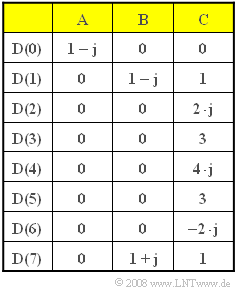Exercise 5.7Z: Application of the IDFT
From LNTwww
In the Discrete Fourier Transform $\rm (DFT)$, the discrete spectral coefficients $D(μ)$ with control variable $μ = 0$, ... , $N – 1$ are calculated from the time sample values $d(ν)$ with $ν = 0$, ... , $N – 1$ as follows:
- $$D(\mu) = \frac{1}{N} \cdot \sum_{\nu = 0 }^{N-1} d(\nu)\cdot {w}^{\hspace{0.05cm}\nu \hspace{0.08cm} \cdot \hspace{0.05cm}\mu} \hspace{0.05cm}.$$
Here, $w$ abbreviates the complex rotation factor:
- $$w = {\rm e}^{-{\rm j} \hspace{0.05cm}\cdot \hspace{0.05cm} 2 \pi /N} = \cos \left( {2 \pi}/{N}\right)-{\rm j} \cdot \sin \left( {2 \pi}/{N}\right) \hspace{0.05cm}.$$
Correspondingly, for the Inverse discrete Fourier transform $\rm (IDFT)$ practically as an "inverse function" of the DFT applies:
- $$d(\nu) = \sum_{\mu = 0 }^{N-1} D(\mu) \cdot {w}^{-\nu \hspace{0.08cm} \cdot \hspace{0.05cm}\mu} \hspace{0.05cm}.$$
- In this exercise, the time coefficients $d(ν)$ are to be determined for different complex-valued example sequences $D(μ)$ – which are labeled $\rm A$, $\rm B$ and $\rm C$ in the table.
- Thus, $N = 8$ is always valid.
Notes:
- The exercise belongs to the chapter Implementation of OFDM Systems.
- Reference is also made to the chapter Discrete Fourier Transform in the book "Signal Representation".
- You can check your results with the interactive applet Discrete Fourier Transform and Inverse.
Questions
Solution
(1) Because of $D(μ) = 0$ for $μ ≠ 0$ all time coefficients $d(ν) = D(0)= 1 - {\rm j}$. Thus also holds:
- $${\rm Re}[d(1)] \hspace{0.15cm}\underline {=+ 1}, \hspace{0.3cm}{\rm Im}[d(1)] \hspace{0.15cm}\underline {= -1}.$$
(2) Here, all spectral coefficients are zero except $D_1 = 1 - {\rm j}$ and $D_7 = 1 + {\rm j}$. It follows for all time coefficients $(0 ≤ ν ≤ 7)$:
- $$d(\nu) = (1 - {\rm j}) \cdot {\rm{e}}^{ - {\rm{j}}\hspace{0.04cm}\cdot \hspace{0.04cm} {\rm{\pi}}/4\hspace{0.04cm}\cdot \hspace{0.04cm}\nu} +(1 + {\rm j}) \cdot {\rm{e}}^{ - {\rm{j}}\hspace{0.04cm}\cdot \hspace{0.04cm} {7\rm{\pi}}/4\hspace{0.04cm}\cdot \hspace{0.04cm}\nu}.$$
- However, due to periodicity, also holds:
- $$d(\nu) = (1 - {\rm j}) \cdot {\rm{e}}^{ - {\rm{j}}\hspace{0.04cm}\cdot \hspace{0.04cm} {\rm{\pi}}/4\hspace{0.04cm}\cdot \hspace{0.04cm}\nu} +(1 + {\rm j}) \cdot {\rm{e}}^{ +{\rm{j}}\hspace{0.04cm}\cdot \hspace{0.04cm} {\rm{\pi}}/4\hspace{0.04cm}\cdot \hspace{0.04cm}\nu}= \left[ {\rm{e}}^{ + {\rm{j}}\hspace{0.04cm}\cdot \hspace{0.04cm} {\rm{\pi}}/4\hspace{0.04cm}\cdot \hspace{0.04cm}\nu} + {\rm{e}}^{ - {\rm{j}}\hspace{0.04cm}\cdot \hspace{0.04cm} {\rm{\pi}}/4\hspace{0.04cm}\cdot \hspace{0.04cm}\nu}\right]+ {\rm{j}} \cdot\left[ {\rm{e}}^{ + {\rm{j}}\hspace{0.04cm}\cdot \hspace{0.04cm} {\rm{\pi}}/4\hspace{0.04cm}\cdot \hspace{0.04cm}\nu} - {\rm{e}}^{ - {\rm{j}}\hspace{0.04cm}\cdot \hspace{0.04cm} {\rm{\pi}}/4\hspace{0.04cm}\cdot \hspace{0.04cm}\nu}\right].$$
- Using Euler's theorem, this expression can be transformed as follows:
- $$d(\nu) = 2 \cdot \cos \left( {\pi}/{4}\cdot \nu \right)+ 2 \cdot \sin \left( {\pi}/{4}\cdot \nu \right).$$
- This time function $d(ν)$ is purely real and characterizes a harmonic oscillation with amplitude $ 2 \cdot \sqrt{2}$ and phase $φ = 45^\circ$.
- The time coefficient with index $ν = 1$ indicates the maximum:
- $$ {\rm Re}[d(1)] = 2 \cdot \frac {\sqrt{2}}{2}+ 2 \cdot \frac {\sqrt{2}}{2} = 2 \cdot {\sqrt{2}} \hspace{0.15cm}\underline {\approx 2.828}, \hspace{0.5cm}{\rm Im}[d(1)] \hspace{0.15cm}\underline {= 0}.$$
(3) According to the general equation:
- $$d(1) = \sum\limits_{\mu = 0}^{7} D(\mu)\cdot {\rm{e}}^{ - {\rm{j}}\hspace{0.04cm}\cdot \hspace{0.04cm} {\rm{\pi}}/4\hspace{0.04cm}\cdot \hspace{0.04cm}\mu} = \left[ D(1) + D(7) \right]\cdot \cos \left( {\pi}/{4} \right) + \left[ D(3) + D(5) \right]\cdot \cos \left( {3\pi}/{4} \right)+ {\rm j} \cdot \left[ D(2) - D(6) \right]\cdot \sin \left( {\pi}/{2} \right) + D(4) \cdot {\rm{e}}^{ - {\rm{j}}\hspace{0.04cm}\cdot \hspace{0.04cm} {\rm{\pi}}}.$$
- The first three terms give pure real results:
- $${\rm Re}[d(1)] = (1+1) \cdot \frac{1}{\sqrt{2}}-(3+3) \cdot \frac{1}{\sqrt{2}}+ {\rm j} \cdot4{\rm j} \cdot 1 = -\frac{4}{\sqrt{2}}-4\hspace{0.15cm}\underline { \approx -6.829}.$$
- For the imaginary part, we obtain:
- $${\rm Im}[d(1)] = {\rm Im}\left[4 \cdot{\rm j} \cdot (-1) \right] \hspace{0.15cm}\underline {= -4}.$$
